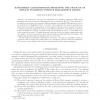Free Online Productivity Tools
i2Speak
i2Symbol
i2OCR
iTex2Img
iWeb2Print
iWeb2Shot
i2Type
iPdf2Split
iPdf2Merge
i2Bopomofo
i2Arabic
i2Style
i2Image
i2PDF
iLatex2Rtf
Sci2ools
JACM
2011
2011
Randomized algorithms for estimating the trace of an implicit symmetric positive semi-definite matrix
We analyze the convergence of randomized trace estimators. Starting at 1989, several algorithms have been proposed for estimating the trace of a matrix by 1 M M i=1 zT i Azi, where the zi are random vectors, have been proposed; different estimators use different distributions for the zis, all of which lead to E( 1 M M i=1 zT i Azi) = trace(A). These algorithms are useful in applications in which there is no explicit representation of A but rather an efficient method compute zT Az given z. Existing results only analyze the variance of the different estimators. In contrast, we analyze the number of samples M required to guarantee that with probability at least 1 − δ, the relative error in the estimate is at most . We argue that such bounds are much more useful in applications than the variance. We found that these bounds rank the estimators differently than the variance; this suggests that minimum-variance estimators may not be the best. We also make two additional contributions t...
| Added | 14 May 2011 |
| Updated | 14 May 2011 |
| Type | Journal |
| Year | 2011 |
| Where | JACM |
| Authors | Haim Avron, Sivan Toledo |
Comments (0)

